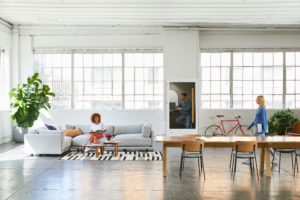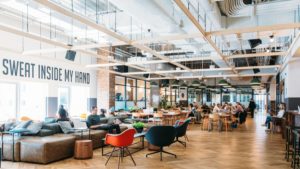 It’s no secret that our environment largely impacts our morale and productivity.
It’s no secret that our environment largely impacts our morale and productivity.
Workplace stress has reached an all-time high in recent years, and many have posited that office design has played a key role in this. After all, it’s hard to operate at your highest potential in a space with dull colours, fluorescent lights, and endless cubicles.
In an age when home offices and co-working spaces with top-of-the-line amenities are becoming more and more popular, it’s imperative that your company master the art of quality office design.
When you do, you’ll no doubt see an immediate improvement in productivity, quality of work, and enthusiasm among your employees. Just as importantly, you’ll be contributing to the health and wellness of your team members as well.
Here are 3 key office design elements to consider as you strive to improve your workplace:
Flexible, open space
The traditional cubicle setup of many offices comes with one big problem: it fosters a lack of interaction among employees. Beyond that, it can be difficult to remain productive when you can hear every last conversation that your cubicle neighbors have with their clients and with each other.
In fact, according to research done at the University of Sydney, over 50% of employees who work out of cubicles cited sound privacy as their biggest workplace dissatisfaction.
It would seem the answer is to move to the open concepts of today’s modern workplaces—but not so fast! An Oxford study shows that open floorplans can threaten productivity and peace of mind, no doubt due in part to the constant visual stimulation as well as lack of visual privacy.
Clearly, even in open, expansive spaces, companies still need to provide employees, particularly more introverted ones, with a quiet space for refuge, where they can recharge in private. Especially since that same Oxford study shows that “the ability to focus and work without interruptions” is what’s most important to respondents in their work environment.
It’s no wonder then that companies like WeWork, which provides office spaces for everyone from entrepreneurs to enterprises, strike a middle ground in today’s working environments. The majority of office spaces available to rent on their platform offer both open spaces as well as private offices, satisfying both those who thrive on interaction as well as those who’d prefer an enclosed space for better concentration.

Lighting
Fluorescent lights are perhaps the most common source of lighting in traditional office buildings. Unfortunately, working under fluorescent lights day-in and day-out has been linked with a number of negative health effects, including:
- Migraines
- Symptoms of seasonal affective disorder or depression
- Stress/anxiety (due to cortisol suppression)
Since fluorescent lights also flicker (to most, the flicker is unnoticeable, but there are those who can perceive it), some employees can additionally suffer from constant headaches and eye strain.
Another problem? The lack of sunlight in office environments can throw off an employee’s circadian rhythms, which affects body function, often leading to sleep difficulty at night. Ultimately, this will impact an employee’s mood and productivity in the workplace, while also increasing stress.
One solution is to change out your fluorescent lighting for incandescent lighting, which provides a better spectrum of light. Light therapy can also counteract a lack of sunlight exposure and improve a person’s quality of sleep. And the light box lamps on the market today are small enough to fit right on a person’s desk.
Of course, nothing beats natural sunlight. According to an article from Psychology Today, “Employees who sit near a window are better at staying on task, show greater interest in their work, and report more loyalty to their company. A 2003 study found that when call center employees—who often rotate seats—are placed near a window, they generate an additional $3,000 of productivity per year. Research even suggests that the amount of direct sunlight entering an office can reliably predict the level of employee satisfaction in a workplace.”
So if you want happier and more productive employees, ensure your work space has as many windows as possible with as much natural light filtering in as can be managed.
Plants
Ron Friedman, Ph.D., author of The Best Place to Work, writes this: “Studies show that the mere presence of plants [in an office] can also provide surprisingly large benefits. Office workers report feeling healthier and more energized when their workplace features live plants and fresh flowers. A 2011 study found that randomly assigning participants to rooms with indoor plants led to significantly better performance on tasks requiring sustained attention and concentration.”
Why is this? “A number of researchers argue that natural settings are cognitively rejuvenating and help us restore our mental resources,” Friedman goes on. “We have the freedom to let our minds wander, noticing as much or as little as we like, entering a state that psychologists term ‘soft fascination.’ The result is an elevation in mood as well as replenished mental energy that improves our memory and enhances creativity.”
Not sure where to start when it comes to selecting the best indoor plants for your workspace? Refer to this article, which shares 20 plants that improve indoor air quality along with information on how to care for them.
If views of natural settings aren’t accessible, given your office location, Friedman says there are alternatives you can consider: aquariums, for instance, put us at ease. Fireplaces encourage us to connect with others. Even pictures of landscapes can positively impact our mood, decreasing stress and anxiety, particularly if they’re rich in blues and greens (which we naturally associate with fertile environments). What’s more, such colours give our creativity a boost, which no doubt leads to better productivity and engagement.
Your company’s work space is the heart of its productivity and output. As such, it makes sense to invest in office design if doing so will greatly improve the productivity, morale, and mental health of your employees.
Simply changing key elements like space setup and lighting, while also adding in a fair amount of greenery or other elements of nature, can go a long way in achieving big results.
Which design elements will you try to incorporate into your workplace this week?
